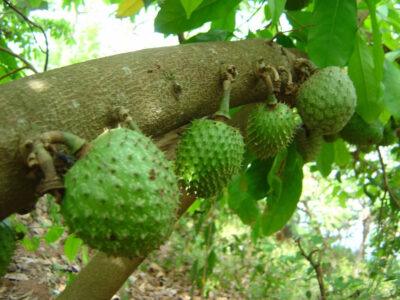If you’ve ever bought soursop in your local market – or even grown it – you know it’s a tangy, sweet treat reminiscent of pineapple and mango.
But what you might not know is that many believe the fruit, which grows on the graviola tree, has the power to treat everything from inflammation to cancer.
Graviola is a small evergreen tree that’s native to Central and South America. It grows all across the tropical regions of Africa, Southeast Asia, the Pacific islands and the Philippines. It is also known as custard apple, Brazilian paw and guanabana, and it belongs in the Annonaceae family. It is scientifically referred to as annona muricata.
The soursop fruit is green, spiky and heart-shaped. It grows up to over a foot long, weighing as much as 15 pounds. Its meaty, delectable flesh is a combination of sweet and sour. It has a soft, mushy texture that approximates the creaminess of an overly ripe Cavendish banana.
The Hidden Secrets Of Making Herbal Medicines…Right At Your Fingertips! [2]
The sweet varieties of graviola are delicious as they are, but most are enjoyed as smoothies or juice. In different parts of the world, they’re also enjoyed as candy bars, fruit nectar, ice cream and sorbet.
The soursop fruit is rich in Vitamin C, dietary fiber, carbohydrates, potassium, B-vitamins like thiamin, riboflavin and niacin, as well as magnesium, calcium and phosphorous.
A Useful Medicine?
Although it is valued for its medicinal use in many parts of the world, only in the past two decades has graviola gained the attention and serious interest of integrative medical practitioners, nutritionists and patients battling chronic disease. The fruit, leaves, twigs, bark and even roots of graviola can all be utilized in natural treatments, but its most active ingredient, the phytochemical Acetogenin, is concentrated in the leaves.
The story continues below the video
Graviola is known to be a diuretic and a sedative, and is used as a remedy for cough, migraine headaches, insomnia, back pain, infections and herpes. The leaves are reportedly effective against head lice and bedbugs. Cancernetwork.com cites its benefits in fighting parasites, stomach ailments, fever, hypertension, rheumatism and depression.
Testimonial after testimonial of the plant’s cancer-fighting abilities abound on the Internet and in alternative health circles, but supporting data from the medical establishment and the mainstream media is limited.
Could This All-Natural ‘Detox’ Capsule Have Extended John Wayne’s Life? [3]
However, the renowned Memorial Sloan Kettering Cancer Center [4] (MSKCC) on its website does share various studies that have been conducted, mostly outside of the U.S., on the medicinal benefits of graviola. In the studies, the plant was found to have anti-inflammatory, analgesic, anti-diabetic, anti-ulcer, anti-viral, antimicrobial and yes, anti-cancer uses. In animal studies, graviola extracts have been shown to be potent against breast, lung, colon, prostate, pancreas, liver and skin cancers, as well as leukemia.
Using Graviola
Graviolas are sold in many Caribbean and Asian markets. They’re also available online and at health food stores as dietary supplements – in capsules, tablets, dried tea leaves, powder for infusions (very dense teas) and tinctures. (Recommended: How To Make Healing Herbal Tinctures, The Old-Fashioned Way [5].)
Always talk to a doctor before talking any medications or supplements and avoid consuming soursop in excessive amounts. The MSKCC site warns of its alkaloid compounds that could cause movement disorders, neurological dysfunction and degeneration leading to symptoms not unlike Parkinson’s disease.
Growing Graviola
Graviola can be grown in Hawaii and Southern Florida within USDA Zones 10 and 11. It can also be grown indoors [6]. Preferring high humidity and warm winters, these tropical plants deteriorate in cold temperatures and can die from even just a brief exposure to frost. They flower and fruit best when temperatures are around 78 degrees Fahrenheit and humidity within 70 to 80 percent. If you live in a cool climate where temperatures dip below 40 degrees F, it’s best to grow them in a sheltered area. If you’re in a sunny region with hot, dry summers, place them in light shade during the sunniest part of the day. Graviolas [7] only reach to about 15 feet, so they can be grown in containers.
Have you ever used graviola? What advice would you add? Share it in the section below:
Harness The Power Of Nature’s Most Remarkable Healer: Vinegar [8]
